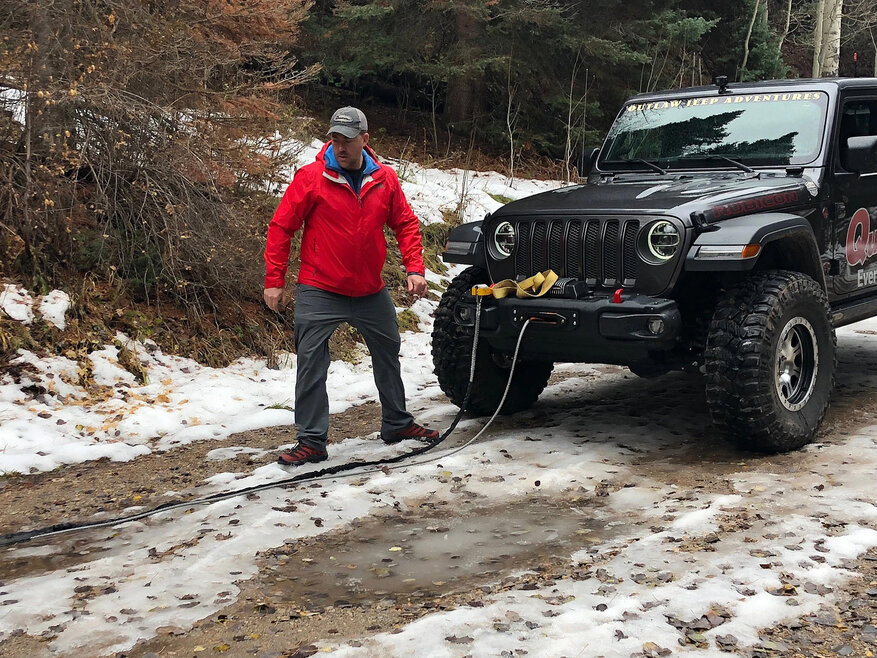by Matt Konkle
Managing Editor
You’ve no doubt seen the terminology.
You are shopping for a new winch, or lighting, or some other device for your Jeep that utilizes electricity.
And you see all the stuff in the product description. Things like power, pulling capacity, line speed, lumens and amp draw.
But somewhere in the mix is also this thing called an IP rating.
Huh?
Well, for some, you may already know what this means. And that’s fine. However, for the vast majority of newer Jeep enthusiasts in the arena, an IP rating might as well mean something like intellectual property.
Well, here is the thing. It doesn’t. But it definitely is something you should understand.
So, here it is. A product IP rating is a globally recognized standard that defines the levels of sealing effectiveness of electrical enclosures against intrusion from foreign bodies (tools, dirt, etc.) and moisture. It consists of two numbers that describe the level of protection a device has against solids (like dust) and liquids (like water).
The abbreviation stands for Ingress Protection, and the first digit after ‘IP’ indicates the level of protection against solid particles, while the second digit represents the level of protection against liquids.
Understanding the First Digit: Solid Particle Protection
So, the first digit of an IP rating ranges from 0 to 6, indicating the level of protection against solid objects and dust. Here’s a brief overview:
- 0: No protection against any kind of physical contact or objects.
- 1: Protection against objects larger than 50 mm, such as a hand.
- 2: Protection against objects larger than 12.5 mm, such as fingers.
- 3: Protection against objects larger than 2.5 mm, such as tools and thick wires.
- 4: Protection against objects larger than 1 mm, such as most wires, screws, etc.
- 5: Dust protected. Ingress of dust is not entirely prevented, but it must not enter in sufficient quantity to interfere with the satisfactory operation of the equipment.
- 6: Dust tight. No ingress of dust; complete protection against contact.
Understanding the Second Digit: Liquid Ingress Protection
The second digit ranges from 0 to 9K, reflecting the device's ability to resist moisture:
- 0: No protection against liquids.
- 1: Protection against vertically falling water droplets, such as condensation.
- 2: Protection against water droplets deflected up to 15 degrees from vertical.
- 3: Protection against spray up to 60 degrees from vertical.
- 4: Protection against water splashes from any direction.
- 5: Protection against low-pressure water jets from any direction.
- 6: Protection against high-pressure water jets from any direction.
- 7: Protection against immersion in water up to 1 meter for 30 minutes.
- 8: Protection against continuous immersion in water under conditions specified by the manufacturer.
- 9K: Protection against high-pressure, high-temperature water jets.
Here are a few examples to understand how these ratings apply to actual products:
IP68: This rating is commonly seen on products normally exposed to the weather for long periods of time. The ‘6’ means the device is dust-tight, and the ‘8’ signifies that it can be submerged in water beyond 1 meter, typically up to 3 meters for a certain duration, as specified by the manufacturer.
IP54: A device with this rating is protected against limited dust ingress (it won’t interfere with the operation of the equipment) and splashing of water from any direction, making it suitable for limited outdoor use.
Choosing the Right IP Rating
When selecting a product, especially something like a Jeep winch or lighting, consider the environment. For harsh environments with a lot of dust and water exposure, products with higher IP ratings (e.g., IP67 or IP68) are recommended. For indoor use where the device might only occasionally come into contact with water, a lower rating (e.g., IP54) might be sufficient.
IP ratings are a crucial factor to consider when assessing what kind of products you want to add on your Jeep. Understanding these ratings can help you make more informed decisions, ensuring that your equipment is suited to its intended environment, offering the best possible protection against dust and water ingress. Whether you're an enthusiast looking for more off-road time, or someone who just wants a durable, waterproof product, IP ratings provide a clear and standardized measure of protection.





















